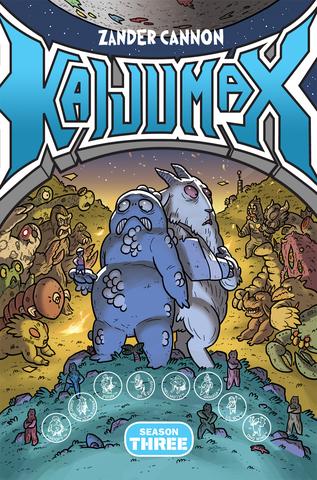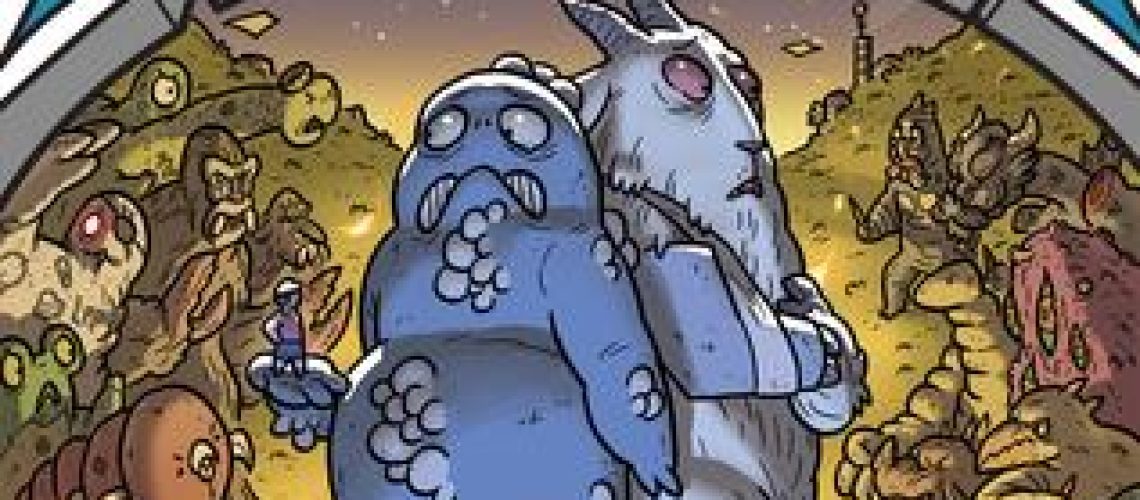Welcome to the latest installment of my comics review column here at Skiffy & Fanty! Every month, I use this space to shine a spotlight on SF&F comics (print comics, graphic novels, and webcomics) that I believe deserve more attention from SF&F readers.
This month, I’m turning my – and hopefully your – gaze back to the latest collection of a series I reviewed last year, one of my favourite SFFnal comics currently in production, Zander Cannon’s epic giant monsters prison drama, Kaijumax. (This review contains spoilers!)

Kaijumax Season Three: King of the Monstas
Created, Written and Drawn by Zander Cannon
Published by Oni Press
At the end of Season Two of Kaijumax, Electrogor, the giant radioactive insect monster who’s been our primary viewpoint character throughout the series, was recaptured and returned to custody in the titular maximum security prison-island for kaiju whom humanity deems a threat.
Electrogor, however, is decidedly in the background for much of Season Three: King of the Monstas, as more focus shifts to other characters and some of the most worrisomely dangling plot threads.
The Creature from Devil’s Creek, as mild and utterly hapless as ever, desperately seeks some kind of peace and security from the constant abuse he suffers from the other inmates, including his nominal allies in the Cryptid Gang.
Whoofy, the naïve and lonely child – or, rather, as we learn in Season Three, the clone – of the legendary Ape-Whale, the currently dead former leader of the J-Pop Gang, tries to lead the fractious monsters around him while the mysterious and increasingly malevolent Little Boy whispers dangerous advice in his ear and the Cryptid Gang plots a war.
Doctor Zhang gets drawn deeper and deeper into the schemes of her lover, the vicious inmate Zonn, while trying to keep their relationship secret from the warden and other guards.
And the Green Humongo stages a musical.
If a central idea of both Kaijumax Season One and Season Two was that, as I discussed in my review of those books, the real giant monster is the carceral state, then Season Three serves to remind us that, at least sometimes, the real giant monster is also the real giant monster. Trauma is central to the narrative of this volume – the trauma of humans hurt by monsters, but even more, the trauma of monsters hurt by monsters.
Electrogor’s trauma, after the brutal sexual assault he experienced from Zonn in Season One, has always been centered. But we learn more about how deeply traumatized both Whoofy and the Creature from Devil’s Creek are. Mechazon, the spiritual leader of the prison’s robot community, is traumatized – also by Zonn, who he was created to but refused to fight, and who mistakes Mechazon’s pacifistic conviction for weakness. Dr. Zhang is increasingly traumatized as her relationship with Zonn takes a more overtly criminal and abusive turn.
Zonn isn’t the architect of all these traumas – Whoofy was viciously bullied by other kaiju, and the Creature from Devil’s Creek, it turns out, is literally the son of the Devil, and his father has no love and very little use for him. The Little Boy’s trauma is a tragic secret that answers all the questions of his presence in Kaijumax, his cruel, feigned friendship with Whoofy, and his poisonous advice.
But Zonn is the key to much of how the plot unfolds, and how a whole range of schemes and gambits collide disastrously when the Cryptid Gang unleash a massive, murderous riot in their bid to become the dominant force inside the prison.
In the chaos, the Creature From Devil’s Creek is pushed beyond his limits, into fear, and inaction. Dr. Zhang is pushed beyond her limits into rage, and violence. Whoofy is pushed beyond his limits into violence, but also, finally, self-sacrifice and compassion.
All of them suffer for it. Trauma has no easy answers.
It also isn’t an excuse. The confrontations that emerge as the plot threads intertwine and the story moves towards this season’s genuinely epic conclusion raise painful questions about intentions, about what it means to want to be good in a world where you’re the little clone of the King of the Monstas, or the literal son of the Devil, but you still rely on those greater, more destructive, inimical powers to do the things that you aren’t willing to do to ensure that you live, and live well.
But there are ways forward. Compassion is a way forward. So is art.
Because the other thread that winds throughout this narrative of trauma, of seemingly powerful but frightened, hurt, angry, lonely giant monsters confronting both their abusers and themselves, is of the healing capacity of art.
Because the Green Humongo stages a musical. And it’s a freaking Hamilton/Godzilla mash-up, and it’s amazing.
I can’t think of a more apt way to depict members of a marginalized group, whose experiences and trauma have been viewed through the gaze of those who fear and hate them, reclaiming their narrative, expressing their pain and their conflicts, and turning it into a source of joy. It’s a brightly hopeful note in an otherwise grim and tragic chorus.
Kaijumax Season Three represents the series firing on every single cylinder, but some of the caveats from my review of previous instalments still apply. The parallels between the experiences of the kaiju and those of real-world marginalized communities of real people are even stronger. Zander Cannon continues to walk a fine line with grace and respect, but the choices he makes won’t work for everyone, and I’d understand if readers who are members of some of those real marginalized communities or have more direct personal experience with the carceral state found it upsetting or trivializing of their experiences. The more explicit partner violence that Dr. Zhang experiences from Zonn merits a similar warning around content.
Moreover, and this isn’t Cannon’s fault, more another example of developments outstripping satire, but recent events could make it even more disturbing for some readers to realize that kaiju children are among the incarcerated in Kaijumax, both with and without their parents – Whoofy, obviously, and also Electrogor’s children.
So yes, Kaijumax Season Three goes very grim indeed, despite the candy-coloured palette, and I want to acknowledge in both cases that my privilege means that material that could be triggering or otherwise upsetting for some readers is safely hypothetical to me.
With those qualifiers in mind, I give Kaijumax Season Three: King of the Monstas my highest possible recommendation. It’s outstanding. If this book isn’t on next year’s Best Graphic Story Hugo ballot, I’ll be stunned.
I’ve said before and elsewhere that this is one of the best science fiction comics currently being published. The sheer, heart-rending brilliance of this volume has inspired me to go farther. Kaijumax is both among the finest current works of science fiction, regardless of medium, and the best current comics, regardless of genre.
It most definitely deserves your attention.
Acknowledgements and Disclosures: I would like to acknowledge that Toronto, and the land it now occupies, where I live and work, has been a site of human activity for 15,000 years. This land is the traditional territory of the Huron-Wendat and Petun First Nations, the Seneca, and most recently, the Mississaugas of the Credit River. The territory was the subject of the Dish with One Spoon Wampum Belt Covenant, an agreement between the Iroquois Confederacy and Confederacy of the Ojibwe and allied nations to peaceably share and care for the resources around the Great Lakes. This territory is also covered by the Upper Canada Treaties. Today, the meeting place of Toronto is still the home to many Indigenous people from across Turtle Island. I am grateful to have the opportunity to live and work in the community of Toronto, on this territory.
Zander Cannon and I don’t know each other well, but we have a number of mutual friends through comics, and we’re Facebook friends. I believe we’ve met in person, at various comics conventions, some years ago now. I don’t think this degree of acquaintance unduly biased my review. I purchased my own copy of the graphic novel.







